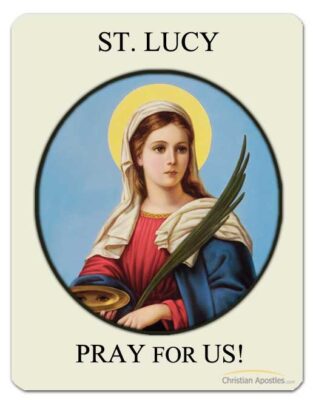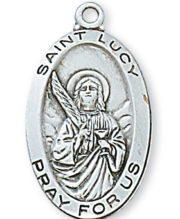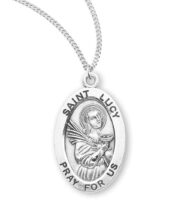Saints
St. Lucy – Patron Saint of Eye Problems and the Blind
Biography of St. Lucy
 St. Lucy is regarded as the patron saint of those with eye problems are suffering an eye illness. The name “Lucy” means “she of the light”. How fitting for this holy woman who serves as the patron saint of all of those who suffer eye problems. Tradition tells us that St. Lucy spent most of her life blind but before her death, God restored her sight.
St. Lucy is regarded as the patron saint of those with eye problems are suffering an eye illness. The name “Lucy” means “she of the light”. How fitting for this holy woman who serves as the patron saint of all of those who suffer eye problems. Tradition tells us that St. Lucy spent most of her life blind but before her death, God restored her sight.
St. Lucy is considered the patron saint of the blind because of a legend that says that her eyes were miraculously healed. According to the story, St. Lucy was a young Christian woman who lived in Syracuse, Sicily, in the 4th century. She was known for her beauty and her devotion to God. When she was approached by a man who wanted to marry her, she refused, saying that she had dedicated her virginity to Christ. The man, furious, reported her to the governor as a Christian, and she was arrested.
As punishment, the governor ordered that her eyes be gouged out. However, the executioners were unable to do so, as the knives they used broke on her eyes. The governor then ordered that she be burned alive, but the fire would not harm her. Eventually, she was beheaded, and it is said that at the moment of her death, her eyes were restored.
Because of this legend, St. Lucy is often depicted holding a dish with her eyes on it, or holding an eye in her hand. She is invoked as a protector of the blind, and her feast day, December 13th, is celebrated by many Catholic and Orthodox churches, especially in Scandinavia. The celebration of the Saint is called “Lucia” which is a festival of lights, that marks the beginning of the Christmas season. Her name “Lucy” means light, and her story is associated with hope, healing and the light of Christ.
The story for how St. Lucy came to be the patron saint of those with eye problems is gruesome but is an example of an unwavering commitment to God. St. Lucy’s suitors commented on how beautiful her eyes were. Rather than marry the suited, as St. Lucy already committed her life to God, her eyes were plucked out and given to the suitors. For this reason, St. Lucy the patron saint of the blind, is often depicted holding a small plate with two eyes on it.
St. Lucy Biography
St. Lucy, also known as Saint Lucia, (283-304 AD) was a Christian martyr from Syracuse, Sicily, who is venerated as a saint by the Roman Catholic, Anglican, and Eastern Orthodox Church. Her feast day is celebrated on December 13th. While there are few historical records of the details of the life of St. Lucy, many stories have been passed down throughout centuries. All of these legends highlight Saint Lucy’s steadfast dedication to Christ and her love for the poor.
St. Lucy is Betrothed to Marry
St. Lucy was born into a wealthy family in Syracuse and was raised as a Christian. She had dedicated her life and her wealth to serving the poor and the needy.
At the age of fourteen she was betrothed to a young pagan nobleman. St. Lucy endeavored in every way to prevent the marriage as she had already given her heart to God.
For the past four years, St. Lucy’s mother had been suffering severe illness, and no physician was found able to help her. Saint Lucy urged her mother to visit the tomb of St. Agatha, in Catania, Sicily. Lucy accompanied her mother to the tomb. Through her prayers and those of St. Agatha, her mother was miraculously healed.
Lucy then told her mother of the promise she had made to God, and begged to be allowed to fulfill it and to sell all her possessions in order to give them to the poor. Her mother, in gratitude for her cure, consented.
St. Lucy’s Persecution and Martyrdom
When the young nobleman to whom Lucy had been betrothed, heard of this, he was enraged and went immediately to Pascasius, the Governor, and denounced her as a Christian. As a result, she was arrested during the persecution of Christians under Emperor Diocletian.
Pascasius ordered Lucy to be brought before him, and commanded her to sacrifice to the gods. When she refused, he ordered her to be taken to a place of shame and treated with indignity.
There is not a clear historical record of how or when she suffered the loss of her eyes, but most careful historians mention this as one of her grievous torments. Other legends state she tore them out herself and gave them to her suiter. In a remarkable miracle, it is said that God restored her sight.
Today, St. lucy is depicted holding a small plate with two eyes on it. St. Lucy is invoked by those who wish to preserve the precious gift of sight. After her death the Christians took her body and buried it at the very place where she had suffered with such constancy, and a church was erected there afterwards bearing her name.
St. Lucy suffered martyrdom on December 13, 304. When her persecutors attempted to seize her and drag her away by force, St. Lucy suddenly became, by the power of God, immovable. The more they tried to move her, the more firmly she stood before them. In his rage, Pascasius ordered a fire kindled around her. Seeing that she was unharmed, one of the servants thrust a sword through her throat.
St. Lucy’s devotion and selflessness, despite her own suffering, and her steadfastness in her faith have inspired many throughout history. Her life and martyrdom continue to be an example of courage, dedication and love for God.
St. Lucy in Church Canon
Both St. Lucy and St. Agnes were martyred in 304; and the Catholic Church to this day, recognizes these two Virgin-Martyrs in the Canon of the Mass as part of Eucharistic Prayer 1 as well as reference to the miraculous healing of St. Lucy’s mother after praying before the tomb of St. Agatha:
To us, also, your servants, who, though sinners,
hope in your abundant mercies,
graciously grant some share
and fellowship with your holy Apostles and Martyrs:
with John the Baptist, Stephen,
Matthias, Barnabas,
(Ignatius, Alexander,
Marcellinus, Peter,
Felicity, Perpetua,
Agatha, Lucy,
Agnes, Cecilia, Anastasia)
and all your Saints;
admit us, we beseech you,
into their company,
not weighing our merits,
but granting us your pardon,
through Christ our Lord.
In addition to being referenced in Eucharistic Prayer I, St. Lucy is is included in the Litany of the Saints, where with St. Mary Magdalene, St. Agatha, St. Agnes, St. Cecilia, St. Anastasia, St. Catherine and St. Clare, they shine as the five wise virgins who took the oil of divine love in their lamps and went joyfully forth to meet their celestial Bridegroom.
Symbolism and Traditions on the Feast of St. Lucy
Popular St. Lucy Medal and St. Lucy Rosary
Prayers to St. Lucy
Prayer for the Intercession of St. Lucy
Saint Lucy, you did not hide your light under a basket,
but let it shine for the whole world, for all the centuries to see.
We may not suffer torture in our lives the way you did,
but we are still called to let the light of our Christianity illumine our daily lives.
Please help us to have the courage to bring our Christianity into our work, our recreation, our relationships, our conversation every corner of our day.
Prayer to Saint Lucy
Saint Lucy,
whose beautiful name signifies light,
by the light of faith which
God bestowed upon you
increase and preserve His
light in my soul
so that I may avoid evil and
be zealous in the performance
of good works,
and detest nothing so much as
the blindness and the darkness
of evil and sin.
Obtain for me, by your
intercession with God
perfect vision for my bodily eyes
and the grace to use them for God’s
greater honor and glory
and the salvation of souls.
St. Lucy, virgin and martyr
hear my prayers and obtain my petitions.
Prayer to St. Lucy for Those with Eye Problems
Relying on Your goodness, O God, we humbly ask You, through the intercession of Saint Lucy, Virgin and Martyr, to give perfect vision to our eyes, that they may serve for Your greater honor and glory.
Saint Lucy, hear our prayers and obtain our petitions. Amen.
Prayer to St. Lucy to Always See the Goodness of the World
Lord, help me to see others in the light of humility and truth. Help me to
see their goodness and virtue and to rejoice in it. Strip from me any falsity
and defamation. Saint Lucy, you died young and innocent, unfamiliar with
the world save for its cruelty. May your double martyrdom, to the flesh and
to life itself, inspire all youth to see Christ and His promises as worth
sacrificing to attain.
Prayer to St. Lucy for Those Who Are Blind
St. Lucy, patron saint of the blind, we pray to you for those who are suffering from blindness or other vision impairments. May they find hope and comfort in your example of courage and faith.
We pray for their physical healing and ask that you intercede on their behalf, asking God to restore their sight or to give them the strength.
We also ask for your guidance and protection as they navigate the challenges of blindness, that they may find joy and purpose in their lives despite their difficulties.
Please bless all those who are working to help the blind, whether through medical treatment, education, or other means. May their efforts be successful and bring hope to those in need.
We ask all these things through Jesus Christ our Lord. Amen.
Prayer to St. Lucy for Relief from Eye Pain
Dear St. Lucy, you are known as the patron saint of those with eye problems. I come to you today, asking for your intercession for relief from the pain in my eyes. I pray that through your powerful intercession, my eyes may be relieved from the pain and discomfort that I am experiencing.
I ask that you pray for me, that my eyes may be healed and that I may give thanks to God for this relief. I place my trust in you, St. Lucy, and know that through your powerful intercession, all things are possible. Amen.
Prayer to St. Lucy for Protection of Vision
Dear St. Lucy, you are known as the patron saint of those with eye problems. I come to you today, asking for your protection and guidance for the preservation of my vision. I pray that through your powerful intercession, my eyes may be protected and that my vision may remain clear and strong.
I ask that you pray for me, that my vision may be protected and that I may give thanks to God for this protection. I place my trust in you, St. Lucy, and know that through your powerful intercession, all things are possible. Amen.
Prayer to St. Lucy for the Healing of Eye Diseases
Dear St. Lucy, you are known as the patron saint of those with eye problems. I come to you today, asking for your intercession for the healing of my eye diseases. I pray that through your powerful intercession, my eyes may be healed and that I may be cured of any eye diseases that I may be suffering from.
I ask that you pray for me, that my eyes may be healed and that I may give thanks to God for this healing. I place my trust in you, St. Lucy, and know that through your powerful intercession, all things are possible. Amen.
Prayer to St. Lucy for Healing of Eye Problems
Dear St. Lucy, you were known for your beauty and your eyes were a symbol of your faith. I come to you today, asking for your intercession for healing of my eye problems. I pray that through your powerful intercession, my eyes may be restored to health and that I may see the world with clarity once again.
I ask that you pray for me, that my eyes may be healed and that I may give thanks to God for this miracle. I place my trust in you, St. Lucy, and know that through your powerful intercession, all things are possible. Amen.
Prayer to St. Lucy for Protection of Eye Health
Dear St. Lucy, you are known as the patron saint of those with eye problems. I come to you today, asking for your protection and guidance for my eye health. I pray that through your powerful intercession, my eyes may be protected from harm and that they may remain strong and healthy.
I ask that you pray for me, that my eyes may be protected and that I may give thanks to God for this protection. I place my trust in you, St. Lucy, and know that through your powerful intercession, all things are possible. Amen.
Prayer to St. Lucy for the Gift of Sight
Dear St. Lucy, you are known as the patron saint of those with eye problems. I come to you today, asking for your intercession for the gift of sight. I pray that through your powerful intercession, my eyes may be opened and that I may see the beauty of the world around me.
I ask that you pray for me, that my eyes may be opened and that I may give thanks to God for this gift. I place my trust in you, St. Lucy, and know that through your powerful intercession, all things are possible. Amen.
How to Pray the Chaplet of St. Lucy
The chaplet of St. Lucy is a devotion that honors the life and virtues of St. Lucy, the patron saint of the blind. The chaplet consists of a series of prayers that are traditionally recited on a set of beads, similar to the Rosary.
To pray the chaplet of St. Lucy, you will need a set of St. Lucy chaplet beads. The chaplet consists of 33 beads, divided into three groups of 11 beads each.
It is tradition to pray the chaplet of St. Lucy on her feast day, which is celebrated on December 13th. However, you can pray the chaplet at any time as a way to honor St. Lucy and seek her intercession for yourself or others.
Step-by-step guide to praying the chaplet of St. Lucy:
-
Begin by making the Sign of the Cross.
-
On the first group of 11 beads, recite the following prayer: “O God, by the prayers of St. Lucy, whose eyes were restored to health, grant that we may see the light of Your truth and be delivered from all blindness of heart.”
-
On each of the next 11 beads, recite the following prayer: “O St. Lucy, virgin and martyr, whose eyes were given back to you in heaven, intercede for us that we may be delivered from all blindness of soul and from every other evil.”
-
On the final group of 11 beads, recite the following prayer: “O God, Who through the intercession of St. Lucy have granted us the favor we have sought, grant us also the grace to persevere in Your love, and to come at last to the enjoyment of Your glory.”
-
Conclude the chaplet by making the Sign of the Cross and reciting the following prayer: “Glory be to the Father, and to the Son, and to the Holy Spirit. As it was in the beginning, is now, and ever shall be, world without end. Amen.”
Alternative prayers for the chaplet of St. Lucy. Recite the prayers as outlined below at each of the medals as described. Starting at the medal of St. Lucy make the sign of the cross and begin:
On the Medal of Saint Lucy:
Lucy, whose beautiful name signifies light, By the light of Faith, which God bestowed upon you, increase and preserve His light in my soul so that I may avoid evil, be zealous in the performance of good works, and abhor nothing so
much as the blindness and the darkness of evil and sin. Obtain for me, by your Intercessory with God, perfect vision For my bodily eyes and the grace to use them For God’s greater honor and glory and the salvation of souls. Saint Lucy, virgin and martyr, hear my prayers and obtain my petitions. (Mention petitions here). Amen.
On the first set of three beads:
Pray the Our Father for the Intention of Preserving the Light of My Eyes so that I may see the beauties of the world
On the second set of three beads:
Pray the Hail Mary for the Intention of Preserving the Eyes of My Soul, the Faith through which I can know my God, understand His teaching, and recognize His love for me.
On the second set of three beads:
Pray the Glory Be for the Intention of the Spiritual Sight of all the Earth
Prayer to recite on the Crucifix:
On the Crucifix O God, our Creator and Redeemer,
mercifully hear our prayers as we venerate Thy
servant, Saint Lucy, for the light of faith Thou didst
bestow upon her, Thou wouldst vouchsafe to
increase and to preserve this same light in our souls,
that we may be able to avoid evil, to do good and to
abhor nothing so much as the blindness and the
darkness of evil and of sin.
Relying on Thy goodness, O God, we humbly ask
Thee, by the intercession of Thy servant, Saint Lucy
that Thou wouldst give perfect vision to our eyes,
that they may serve for Thy greater honor and glory,
and for the salvation of our souls in this world, that
we may come to the enjoyment of the unfailing light
of the Lamb of God in paradise. Saint Lucy, virgin
and martyr, hear our prayer and obtain our
petitions. St. Lucy, pray for us.
Pope Francis’ Reflection on St. Lucy
Pope Francis was ordained on December 13th, the feast of St. Lucy. St Lucy is the patron saint of eye problems. Below is a reflection by Pope Francis on the lessons we can all learn from the holy life of St. Lucy.
 St. Lucy, a martyr from Syracuse, reminds us by her example that the highest dignity of the human being consists of bearing witness to the truth, following one’s own conscience at all costs, without duality and without compromise. This means staying on the side of the light, serving the light, as her very name “Lucy”, “she of the light”, evokes. Being clear, transparent people, being sincere, communicating with others in an open, clear, respectful way. In this way one contributes to spreading light in the environments where one lives, making them more humane, more livable.
St. Lucy, a martyr from Syracuse, reminds us by her example that the highest dignity of the human being consists of bearing witness to the truth, following one’s own conscience at all costs, without duality and without compromise. This means staying on the side of the light, serving the light, as her very name “Lucy”, “she of the light”, evokes. Being clear, transparent people, being sincere, communicating with others in an open, clear, respectful way. In this way one contributes to spreading light in the environments where one lives, making them more humane, more livable.
Starting from this cue we take from the figure of Saint Lucy, I see those who suffer sight impairments as a constructive force in society, which is going through a difficult time. This perspective may see strange, because we usually associate with disability the idea of need, assistance and at times – thank God, less and less – a certain pietism. No, the Pope does not look at you in this way; the Church does not look at you like that. The Christian point of view on disability is no longer, and must never be pietism or mere assistentialism, but rather the awareness that fragility, assumed with responsibility and solidarity, is a resource for the social body as a whole and for the ecclesial community.
Blind and partially-sighted people, well-formed in ethical principles and in civic consciousness, are on the first line for building inclusive communities, where each person can participate without being ashamed of his or her own limits and frailties, cooperating with others to complement and support each other. And we all need each other, not only people with problems of physical frailty; we all need the help of others to go forward in life, because we are all weak at heart, all of us. Yours is an association that has just surpassed one hundred years; it is a reality that by now belongs to national history: protecting the rights of people with sight disabilities, you have cooperated in the civil growth of the country. I encourage you to go forward with an ever more constructive, proactive style, as a force that conveys confidence and hope.
The world needs hope, and this comes above all from the witness of people who, in their condition of fragility, do not close themselves away, do not weep over themselves, but engage together with others to improve things.
Indeed, Saint Lucy is described in precisely this way: as a young and defenseless woman who nevertheless does not give in to threats and flattery, but on the contrary responds with courage and stands up to the judge who interrogates her. With the protection and example of Lucy, go forward!
Other Papal Writings on St. Lucy
Several Popes have spoken about St. Lucy and her significance in the Catholic Church.
Pope Pius XII, in his encyclical letter “Sacra Virginitas” (On Consecrated Virginity) in 1954, praised St. Lucy as a model of virginity and devotion to God. He wrote, “the Church has always honored and invoked her, not only as a virgin and martyr, but also as a model of the consecrated life and an advocate of the Christian people.”
Pope John Paul II, in his homily at the canonization of St. Rita of Cascia in 2000, also spoke about St. Lucy as an example of devotion and faith. He said, “Like St. Lucy, St. Rita is a shining example of the power of faith and the strength of God’s grace to overcome even the most difficult trials and challenges.”
Pope Francis, in a homily in 2013, spoke about St. Lucy as a model of courage and perseverance. He said, “St. Lucy, a young girl, was able to remain faithful to the Lord even in the face of persecution and death, and she is an example of courage and perseverance for all of us.”
In conclusion, Popes have praised St. Lucy as a model of devotion, faith, virginity, and consecrated life, as well as a model of courage, perseverance, and an advocate for the Christian people. They have also recognized her as an example of faith and the strength of God’s grace to overcome trials and challenges.
Children’s Story About St. Lucy
Once upon a time, in a far-off land, there lived a young girl named Lucy. She was kind and gentle, and she loved to help others. She also had the most beautiful eyes, as blue as the sky on a clear day.
One day, while Lucy was walking through the village, she came across a blind man. He was sitting on the side of the road, crying because he could not see. Lucy felt sorry for him and wanted to help. She asked him what was wrong, and he told her that he had been blind for many years and that he had given up hope of ever seeing again.
Lucy knew that she had to do something to help him. She closed her eyes and prayed to God for the blind man’s sight to be restored. When she opened her eyes, the blind man was no longer crying. He was looking around in amazement, and he could see!
The blind man was overjoyed and thanked Lucy for her kindness. He told everyone in the village about the miracle that had happened, and soon, many more people came to Lucy for help. She prayed for the sick and the suffering, and many were healed.
From that day on, Lucy was known as a kind and powerful helper. People from all over the land came to her for help and guidance. Lucy always helped them with a kind heart and a gentle spirit.
One day, Lucy was captured by the Romans because of her Christian faith and they wanted her to renounce her faith, but she refused. They tortured her and killed her, but even in her death, she was an inspiration to many.
Even though Lucy is no longer with us, her spirit lives on. She is remembered as a kind and selfless helper who always put others before herself. And as long as people remember her, her legacy will never be forgotten.
Lessons Learned from St. Lucy
-
Devotion to God: St. Lucy was known for her deep devotion to God, even in the face of persecution and death. She is an example of the importance of staying true to one’s faith and maintaining a strong spiritual life.
-
Courage and Fortitude: St. Lucy was courageous and strong in her faith, even when faced with death. She is a reminder of the importance of standing up for what is right and remaining steadfast in one’s convictions.
-
Purity and Chastity: St. Lucy is a model of chastity and purity. She refused to marry the man who wanted her and chose instead to remain a virgin, dedicating her virginity to Christ. She is a reminder of the importance of living a chaste life and remaining pure.
-
Perseverance: St. Lucy is a reminder of the importance of persevering through difficult times. Despite the cruel punishment she received, she did not renounce her faith and was able to endure her suffering until the end.
-
Hope and Healing: St. Lucy’s miraculous healing of the eyes, the protection from fire and the healing of illnesses that have been attributed to her intercession, are a reminder of the hope and healing that can come through faith in God.
-
Protector of the blind: St. Lucy is the patron saint of the blind and her story and her miracles are a reminder of the power of intercession and the importance of asking for help and guidance when in need.
Reflecting on the Life of St. Lucy in Today’s World
One can easily imagine what a young Christian woman had to contend with in a non-Christian society back in the year 304. Imagine the pressures and challenges we face in our own society in this day and age amidst a culture of pleasure-at-all-costs and the barriers it presents against being with Jesus.
St. Lucy’s friends must have mocked and criticized St. Lucy’s commitment to Jesus, at the time an obscure itinerant preacher in a far-off nation that had been destroyed more than 200 years before. Lucy believed with
her whole soul that Jesus had risen from the dead. Heaven had put a stamp on all he said and did. St. Lucy had such deep and unwavering commitment to her faith that she had made a vow of virginity.
What a commotion this must have caused among her non-Christian friends! The kindlier ones just thought her a little strange. To be pure before marriage was an ancient Roman ideal, rarely found, but not to be condemned. To exclude marriage altogether, however, was too much. She must have something
sinister to hide. The gossip that profession of faith must have stirred would be a challenge for anyone to handle.
St. Lucy knew of the heroism of earlier virgin martyrs. She remained faithful to their example and to the example of the Jesus, whom she knew to be the Son of God.
And so she chose to be committed to Jesus as she looked to him to direct her in life and inspire her in death. She discovered the freedom expressed by Isaiah in the Old Testament reading professed on the feast day of St. Lucy each year:
He gives power to the faint,
and strengthens the powerless.
Even youths will faint and be weary,
and the young will fall exhausted;
but those who wait for the LORD shall renew their strength,
they shall mount up with wings like eagles,
they shall run and not be weary,
they shall walk and not faint.
What perfect description of what we experience when, like St Lucy, we commit our lives Jesus. St. Lucy, pray for us!
Reflection on the Feast Day of St. Lucy
The feast day of St. Lucy is celebrated on December 13th.
St. Lucy was a Christian martyr who lived in the 4th century AD. She is known for her devotion to God and her willingness to die for her faith. She is the patron saint of the blind, those with eye problems and of the city of Syracuse, Italy.
On the feast day of St. Lucy, we remember her deep faith, her devotion to God and her willingness to die for her faith. She serves as a powerful example of how one person can make a significant impact on the world through their devotion to God and their willingness to serve others.
One of the things that stands out about St. Lucy is her devotion to God, despite the persecution that she faced. She reminds us that our faith is not something to be taken lightly, but something that should be lived and shared openly with others, even if it means facing persecution or death.
As we celebrate the feast day of St. Lucy, let us take inspiration from her example of deep faith, devotion to God and her willingness to die for her faith. Let us be reminded that, as followers of Christ, we are called to stand up for our beliefs and to be willing to make sacrifices for our faith.
In addition, let us also remember St. Lucy as the patron saint of the blind, those with eye problems and of the city of Syracuse, Italy. Let us take this opportunity to reflect on the role of the saints in our lives, and how their examples can inspire us to live more fully for God, and also to offer our help and support to those who are suffering from eye problems.
Discover biographies, prayers, and reflections for more than 400 Catholic Saints
Next up: Biography of St. Luigi Orione
Also check out our handmade St. Lucy Medal and St. Lucy Rosary and St. Lucy Rosary Bracelet .













